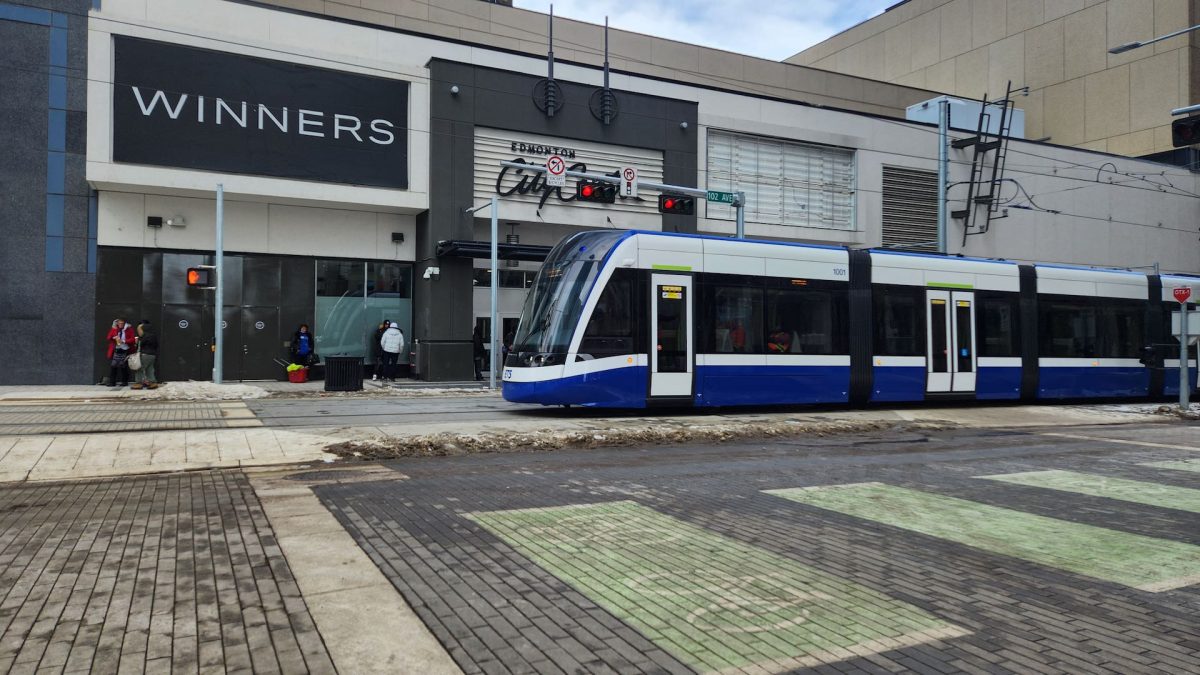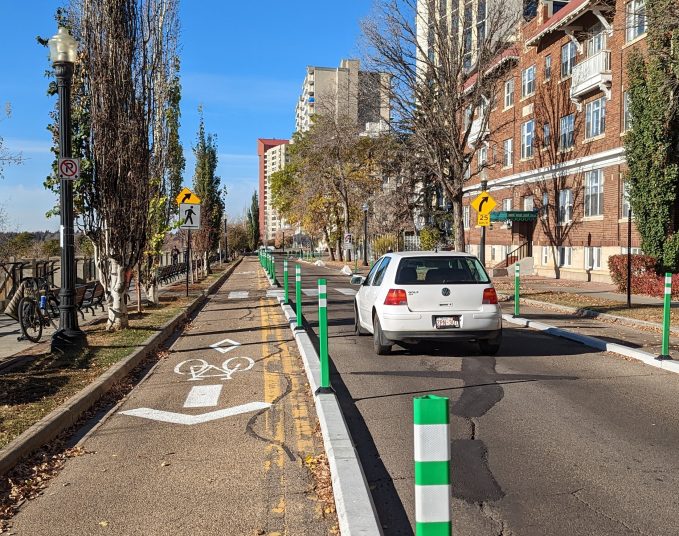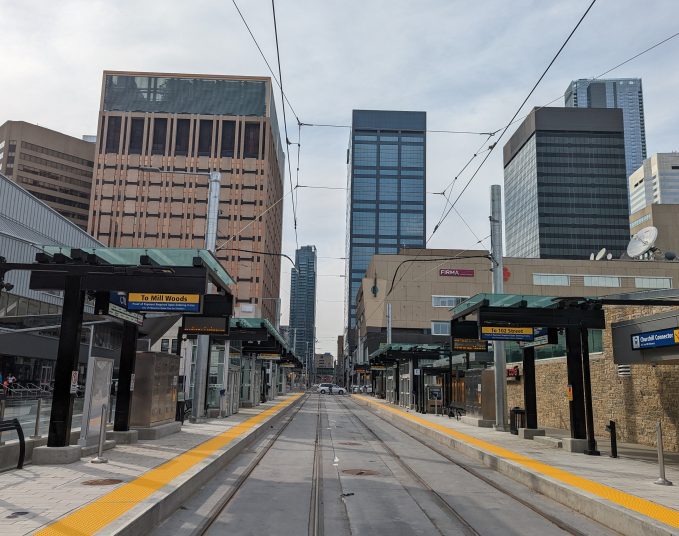In January, when a Valley Line Southeast train and the driver of a Mazda collided on Whyte Avenue, Edmonton’s motorists dominated the ensuing conversation. “This [collision] will be a first of many with low-floor trains,” announced one of many on Twitter. Despite writers raising concerns about the train’s walkability several times, including on this site, few in Edmonton have seemed bothered. But when an SUV’s door got crumpled by a train, it was news.
Transit advocates like myself anticipated this — and have grappled with it since 2017, when the City released traffic-wait modelling on the Valley Line. We countered that these trains that function like other vehicles on streets (such systems are called trams outside of Canada) are safe elsewhere. What might appear exotic, strange or risky for Edmonton, we added, is normal and safe in cities across the world. After the crash, mobility consultant David Cooper echoed this, explaining to Global News that the Valley Line “follows a lot of industry standards” like new trains in Minneapolis, Portland and Toronto.
The City of Edmonton has said much the same about our new, $1.8-billion, 13-kilometre tram (let’s call it what it is) from Mill Woods to downtown. “From Denver and Toronto to Helsinki and Amsterdam, cities around the world have successfully integrated low-floor, urban-style LRT into their communities,” the City said, in a 2022 press release. After the January collision, the City told news media that drivers will simply have to adapt to a new system without bells or crossing arms, like those used on our legacy LRT — and stop turning right on red near the train.
Advocates, myself included, have accepted this argument. Our new tram is the same as other urban trams. It doesn’t need bells or crossing arms, and, indeed, will be safe like in Denver, Toronto, Helsinki and Amsterdam. But are we right?
At least one transit expert says he’s not entirely sure. Edmonton’s new tram is objectively different from most, says Reece Martin, a Toronto-based transit planner who’s become a leading critical voice on transit through his popular YouTube channel. “Yes, this type of system is common around the world,” Martin says. But Edmonton’s has “unique” differences, he adds, that make our expectations on safety far less certain.
First, the tram runs along Edmonton’s roads, and these aren’t like streets in Amsterdam or Helsinki, let alone Toronto or Portland. Instead, in many places, our tram runs along multi-lane roads with drivers travelling at 60km/hr or more — think 75th Street, for example. “It’s not a transit-first environment,” Martin says.
Second, our trams are big. Edmonton’s will stretch up to 84 metres to carry up to 550 passengers in their two-car configurations during rush periods (and half this in single-car form). Trams elsewhere are smaller: In Manchester, they’re 28 metres long; in Zagreb, 32 metres long. Toronto’s new streetcars measure 30 metres long, and Kitchener-Waterloo’s new trams are basically one of Edmonton’s two cars, at 40 metres long.
The main reason for this, Martin explains, is institutional. Canada isn’t fast or cost efficient at building rail, so we tend to build one big project rather than multiple. Since we have one line to work with, we have to move a lot of people to make it worthwhile. Hence, big trains.
The City has ensured this, too. In 2021, it released a report that called for the Valley Line to boost capacity and double-up on cars, to limit overcrowding.
The third difference, Martin says, is Edmonton’s supersized intersections, including the one at Whyte and 83rd Street that hosted the collision that inspired this column. “That’s like a six- or seven-lane road and then [the tram] crosses into the middle of the street to the south. You would just never see that in Europe because they don’t really have roads at this size. And so, when you have that much traffic interacting with [rail] vehicles operating at street level, that can create a lot of conflict.”
Martin notes that just north of this intersection the tram track crosses the roadway again, hopping from the west to the east side. This adds more potential conflicts. And this is over just a few blocks of a 13 kilometre line.
Safe design removes as many conflicts as possible to make streets simple — think a slow, narrow, walkable street with a tram in Amsterdam as an example. Edmonton’s new tram is being built, we must never forget, to boost our city’s walkability and urban potential. Yet it relies on long, heavy trains that can’t stop quickly, and its users will have to observe a lot of signs and safety rules. Pedestrians even get beg buttons.
The reason, Martin says, is that we’re “retrofitting” a tram onto streets that we haven’t reworked to match. “The question is, is that actually safe?” If, for example, a pedestrian has to look in three different directions to see if there’s a car or a train coming (and here, please consider the new crosswalks at Connors Road and 95th Avenue), no sign or signal will make it inherently safe. “It’s just information overload,” Martin says.
The argument that trams don’t have safety challenges isn’t exactly true, either. Melbourne has built 250 kilometres of tramway with 1,763 stops — the largest network in the world. There, collisions between a vehicle and a tram have recently increased by 60 per cent. In 2022, there were 960 collisions, 166 of them serious, and up to 10 trams were taken out of service for repairs from collisions on any given day. “It’s very often we see a car turning right in front of a tram,” said one official in Melbourne, in a news report. “That’s the most frequent incident. When a car is turning right and forcing the tram to stop, with passengers. There’s very often a passenger [on a tram] that falls.”
My hometown, Kitchener-Waterloo, opened a tramway vaguely similar to Edmonton’s in 2019 (it uses the same Flexity trams but the route is mostly on calm streets). Tellingly, the first person injured wasn’t in a car — but on a bicycle. Earlier this month, a 49-year-old male pedestrian died on the tracks. CTV has reported the system has seen 24 collisions between May 2019 and March 2023.
So, back to safety: The volume of people moving on these systems makes the number of collisions relatively low compared to our normal, which is the ridiculous daily rate of collisions and injuries for drivers. But the results from Europe’s tram experience are a touch sobering. Research there suggests the majority of injuries from collisions involving trams are borne not by drivers, but by pedestrians. The most common area injured? The head.
Worse, and to Martin’s broader point about streets, the danger isn’t just trams. Take, again, the intersection at Whyte and 83rd Street. As I’ve written, if one were trying to walk here, the crosswalks don’t even line up. And crossing the multiple lanes and train tracks, each containing threats, takes a reasonably fit me nearly all the offered time the light provides, too. Would I take my 80-year-old mom who uses a walker here? No. But the pedestrians using this intersection will, nonetheless, be residents of similar age from a cluster of nearby retirement homes.
It’s likely there will be challenges with the Valley Line and a sharp learning curve. Once the line opens and a few high-profile collisions wake everyone up to the dangers, as well as the costly downtime they cause for the system, most will pay more attention and collisions will likely decrease. This will mean Edmonton will be moving up to 6,600 people per hour through streets once clogged with cars carrying but one person in each. The overall benefit will be huge.
The overarching problem, though, is we could have done more on safety. As Martin says, Canadian politicians want trams to build better cities but our bureaucracy lacks the expertise to deliver them. What we tend to get, then, are systems designed by people who don’t care much about them, he says.
And that matters for safety. “Like, maybe [a politician has] been to Amsterdam, but they don’t really think about why Amsterdam is safe,” Martin says. “They don’t even necessarily recognize that there’s compromises [on street design] that they need to make if they want this thing to work. You can’t just build transit and the wide road and expect that like, ‘Hey, we’re Amsterdam now.’”
Finally, I reached out to a prominent international consulting firm involved in the Valley Line’s initial design; it said it could not comment. I reached out to TransEd, which is building and will operate the tram whenever it opens; it said no one was available for an interview. One TransEd communications staffer suggested I might ask the City about the city’s decision for a system without bells and gates, and that TransEd has followed its contractual obligations.
Savvy AF. Blunt AF. Edmonton AF.




